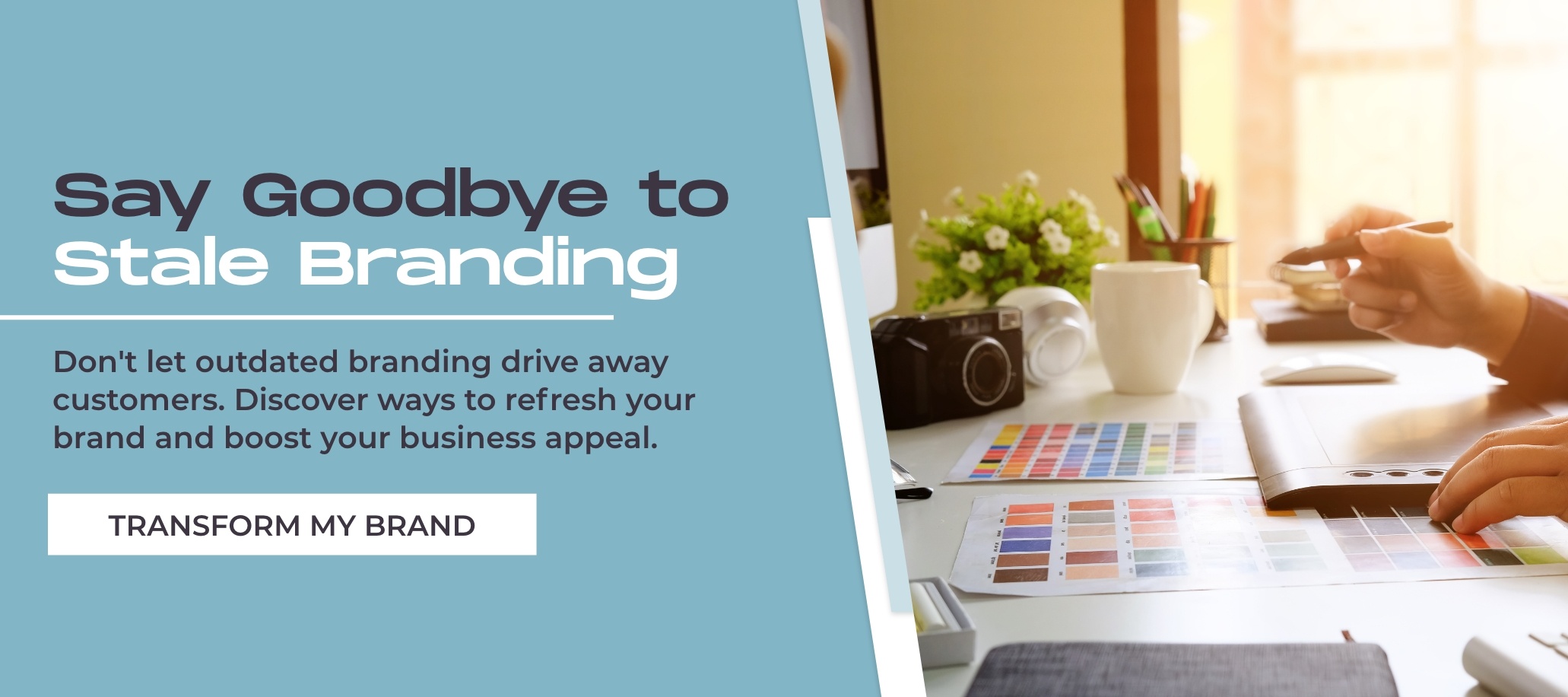TABLE OF CONTENTS
Why Is Consistent Branding Important? | Creating Rock-Solid Brand Guidelines |
What to Include in Your Brand Style Guide | FAQs
From the initial concepts to many rounds of designs, final files, and then rollout, a lot of energy goes into the process of creative branding — and for good reason.
That said, many businesses live without comprehensive branding guidelines for their teams. This is usually how it looks when your team is not aligned on the company branding…
The Sales team creates a proposal and uses whatever fonts they think look good; the Management team creates a PowerPoint presentation and uses purple and yellow when the brand colors are blue and orange; the Operations team creates a how-to sheet and stretches the logo to fit the space so the letters are now a funny shape; and so on.
These inconsistencies are all reasons to create a brand guide for your company and distribute it to your teams.
We understand this disorganization and the branding process because we lived through it ourselves when we rebranded our agency in 2020 and finally were able to roll out reliable brand guidelines.
Why Are Consistent Brand Guidelines Important?
Memory plays a significant role in consumer behavior. Memory can provide comfort. Encountering something familiar allows you to relax and notice other deeper details. A prospect sees your logo and relates it to a positive past experience they had. You are now able to move to the next step and continue to gain their trust, moving forward to a sale.
However, if the prospect is not able to pull on memory with your brand because they encounter different iterations, you start the introduction process over and over again, like “50 First Dates.”
With each varying communication and representation of your business, users’ trust is eroded, or credibility is never built to start with. After all, if you don’t know who you are, why should a prospect take the time to figure you out?
Creating a reference for the elements of your company branding ensures brand consistency, builds trust for your clients, and creates much less confusion for your team.
How to Create Rock-Solid Brand Guidelines
The process of creating your brand guide doesn’t just sit with a graphic designer. Your leadership team should come together and agree on the company brand components first. An experienced branding agency can also help facilitate these decisions.
- What are your official brand colors?
- What are the rules for how your logo should and shouldn’t be used?
- How should your business name be written, or not written?
- What are the branded pieces your team uses often — info sheets, Word docs, presentations, sales sheets?
- Which client-facing or internal pieces could you apply branding to that are currently not marked with your company’s identity?
Once you have these questions answered, a graphic designer or branding specialist can pull the elements together into a comprehensive brand guide for your business.
Basics to Include in Your Brand Guide
Logo Usage
Visually show the proper use of your logo, such as in a box, with and without an icon. Include whether a registered or trademark symbol should be used. Also, show variations of your logo, such as an approved horizontal and vertical version for use in different spaces, or color variations.
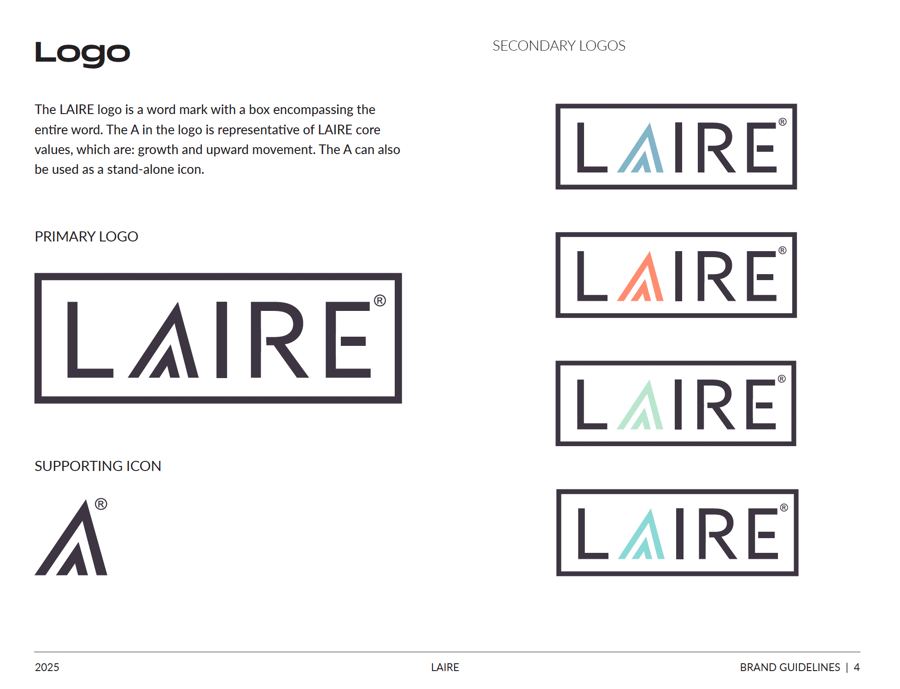
Show the improper use of your logo as well, which may include slanting, shortening, or using unpermitted colors or improper spacing.
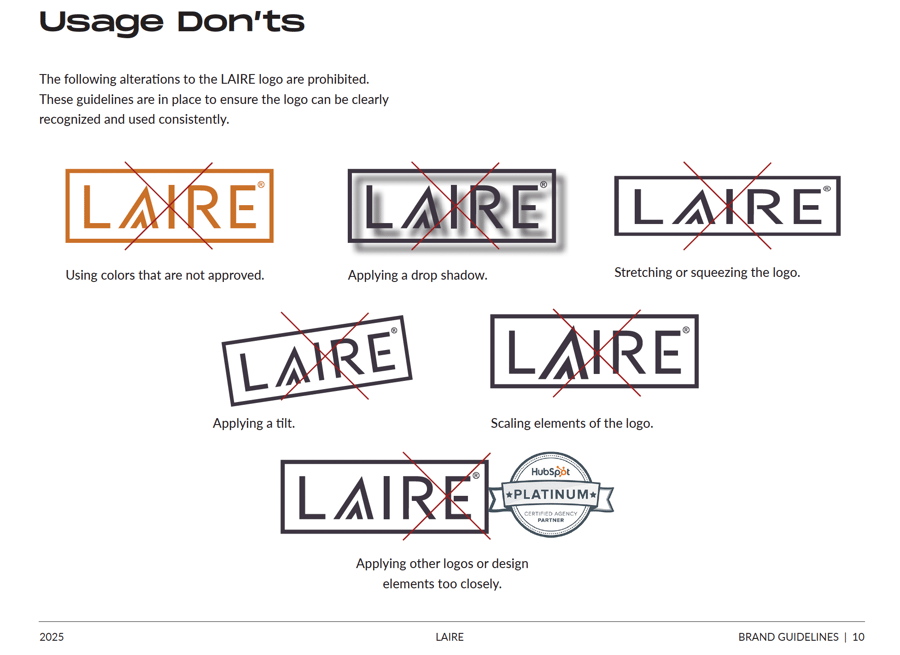
Speaking of spacing … provide spacing requirements around the logo, plus the overall size of the logo. If you have a tagline, include it as well as the rules for usage.
Lastly, provide links to logo files for anyone to access the correct version. You should create and provide versions of the logo in full color, in black and white, in one solid color, and in just white. Also, include versions of your logo that have a white background and a transparent background.
Name Particulars
When your business name is written (not a logo), share the rules. For example, if the name is two words, is there a space between or no space?
Other brand name consistency guidelines may include:
- Whether a registered or trademark symbol should be used in the written version
- Use of capitals or no caps
- Examples of possessive use
Typefaces
Show typefaces used in the logo and then those used for other content on your website, social media profiles, and other platforms. This includes headlines, subheadlines, and body copy, as they’re not always the same as your logo fonts.
Include links to the fonts for your team or vendors to download or access, such as Google or Adobe typefaces or purchased fonts.
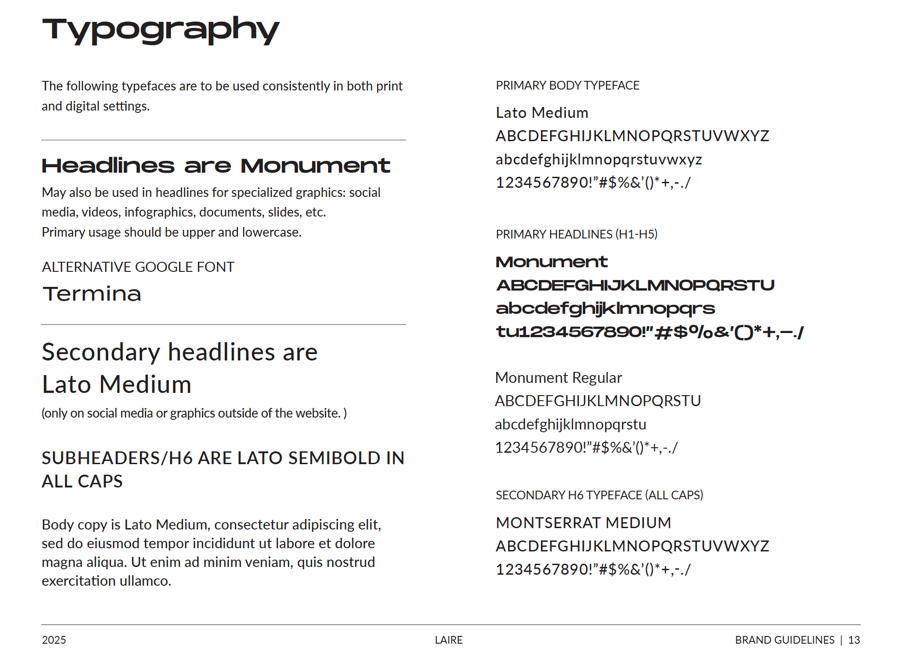
Color Palette
Show the palette of the primary brand colors and where they should be used, such as headlines on documents. Primary colors are often those used in your logo.
Also, include the palette of secondary brand colors and where they should be used. These are accent colors that are complementary to the brand colors and can be used on the website to draw attention to calls to action, in presentations, or in charts and graphics.
Provide color codes for all sign and production processes: CMYK, RGB, Pantone, and HEX.
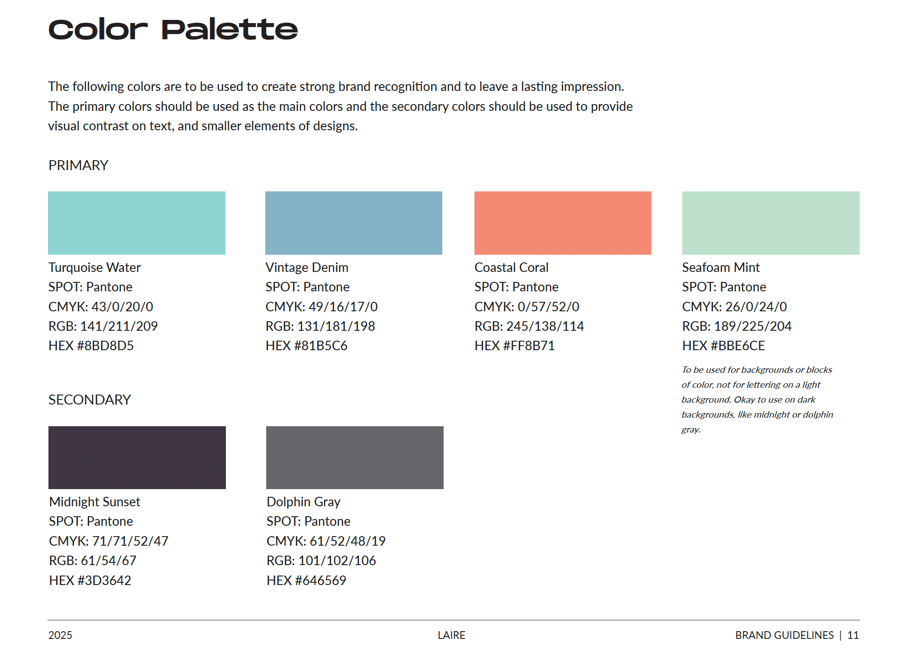
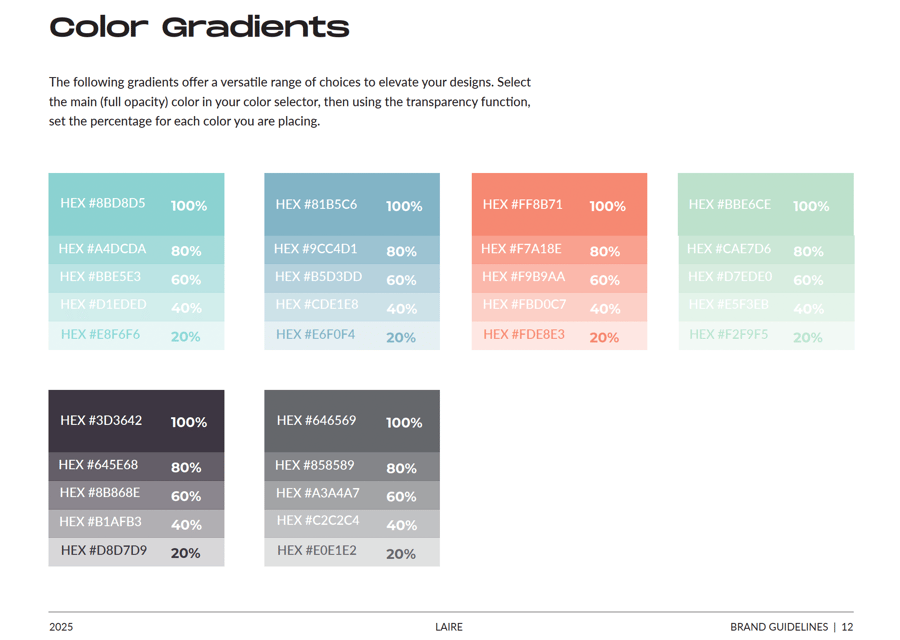
Template Usage
For commonly used documents, such as cover sheets and presentations, design brand-approved templates for these pieces and include links to the files so the team can access them and make copies.
Other Items to Include in Your Brand Guide
- Voice: Outline the point of view of your business, including character, purpose, tone, and language. Include key phrases and words that your company messaging should and shouldn’t use.
- Email Signatures: Unify every touchpoint your team has with a client. Create a solution for an email signature that will work for your teams’ various email services. Show variations based on the needs of your team, such as a team member’s photo, logo, meeting links, etc.
- Graphics: Include templates for often-used graphics such as social media, blog titles, or client reviews.
- Promotional Items/Swag: If your company will be producing giveaway items like clothing or office supplies, show sample placements and items that are on-brand in function or color.
- Imagery: For stock or original photography, outline the suggested style and subject matter, such as photos with people, without people, close-ups, landscapes, etc. Also, include any color overlay or filter details that are used to create a consistent brand look on the website and presentations.
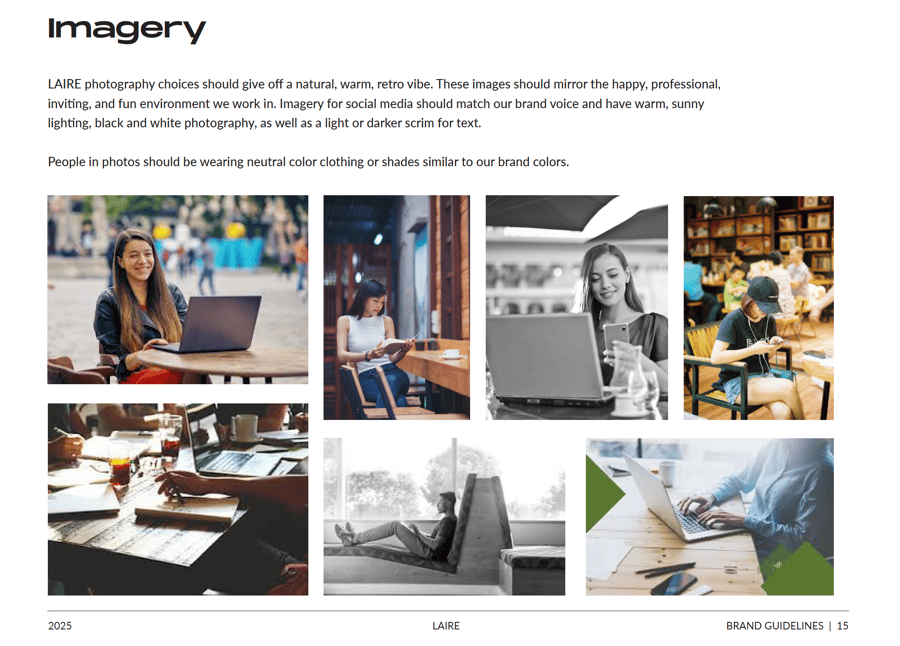
FAQs: Creating and Using a Brand Guide
What is a brand guide, and why does my company need one?
A brand guide (or brand style guide) is a document that defines how your brand looks, sounds, and feels across every touchpoint, from your logo and color palette to tone of voice and email signatures.
It keeps your team aligned, ensures visual and verbal consistency, and strengthens brand recognition with your audience. Without it, your brand risks looking disorganized and unprofessional.
Who should be involved in creating a brand guide?
Branding isn’t just a design project; it’s a strategic process. Your leadership, marketing, and design teams should collaborate to define the brand’s identity, values, and personality. Once those elements are agreed upon, a designer or branding agency can turn them into a polished, easy-to-follow guide.
How detailed should my brand guide be?
That depends on the size of your organization and how many people touch branded materials. A small business might start with logo, colors, and fonts, while larger companies benefit from including templates, tone of voice, and specific use cases. The goal is to make it clear, accessible, and easy to apply.
How do I ensure my team actually uses the brand guide?
Make the brand guide easy to find. Store it in a shared folder like Google Drive, Dropbox, or your company’s intranet.
Host a team meeting or training to walk through the key elements and show how to apply them. Include links to downloadable templates and logo files so team members can quickly grab what they need.
How often should we review or update our brand guide?
Review your brand guide at least once a year or whenever your company goes through a major change, such as a rebrand, new service launch, or platform redesign. Consistent check-ins keep your branding modern and aligned with your business goals.
Introducing ... Your Brand Guide
Once the guide is complete and the components are accessible, meet with your team to discuss the brand standards and processes that your company will follow to adhere to them.
Also, open the conversation for future brand guide adjustments, such as what a team member should do when a new document or template needs to be created. Create a plan for rolling out the changes beyond templated documents, such as website updates and social media profiles.
Consistent brand guidelines give your prospects, customers, and partners a cohesive and positive brand experience. Consistency communicates quality. Quality equals trust. Trust leads to more interactions with your prospects and clients. Then, ta-da — increased revenue.
Need help creating a stronger and more memorable impression for your organization? Our free, 20-minute branding assessment can help.

